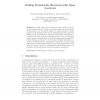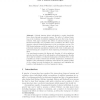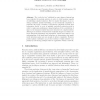ECAL
2007
Springer
14 years 5 months ago
2007
Springer
Abstract. Proteins, under native conditions, fold to specific 3D structures according to their 1D amino acid sequence, which in turn is defined by the genetic code. The specific...
ECAL
2007
Springer
14 years 5 months ago
2007
Springer
Cultural learning allows individuals to acquire knowledge from others through non-genetic means. The effect of cultural learning on the evolution of artificial organisms has been...
ECAL
2007
Springer
14 years 5 months ago
2007
Springer
Abstract. In recent years simulation tools for agent-environment interactions have included increasingly complex and physically realistic conditions. These simulations pose challen...
ECAL
2007
Springer
14 years 5 months ago
2007
Springer
Abstract. In the natural world, individual organisms can adapt as their environment changes. In most in silico evolution, however, individual organisms tend to consist of rigid sol...
ECAL
2007
Springer
14 years 5 months ago
2007
Springer
There are examples of robotic systems in which autonomous mobile robots self-assemble into larger connected entities. However, existing systems display little or no autonomous cont...
ECAL
2007
Springer
14 years 5 months ago
2007
Springer
Anticipation is one of the key aspects involved in flexible and adaptive behavior. The ability for an autonomous agent to extract a relevant model of its coupling with the environ...
ECAL
2007
Springer
14 years 5 months ago
2007
Springer
The “order for free” exhibited by some classes of system has been exploited by natural selection in order to build systems capable of exhibiting complex behaviour. Here we expl...
ECAL
2007
Springer
14 years 5 months ago
2007
Springer
To look for an answer to the puzzle of why complexity may increase, this paper looks to the major evolutionary transitions – a recurring pattern where individuals give up their r...
ECAL
2007
Springer
14 years 5 months ago
2007
Springer
Abstract. When bees and wasps leave the nest to forage, they perform orientation or learning flights. This behaviour includes a number of stereotyped flight manoeuvres mediating ...
ECAL
2007
Springer
14 years 5 months ago
2007
Springer
We describe two simple simulations in which artificial organisms evolve an ability to respond to inputs from within their own body and these inputs themselves can evolve. In the fi...




